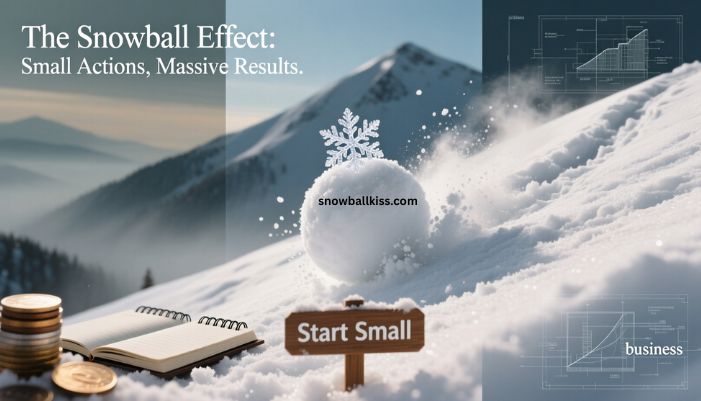Snowballing means something small grows bigger as it rolls forward. Like a snowball that gets larger as it picks up more snow, your efforts or problems can grow too. This can be good or bad, depending on what is growing.
You see snowballing in money, work, health, and habits. It often starts with one small thing. Then it builds up over time. You move forward little by little. As you keep going, your results grow faster.
Let’s look at how this works in real life.
Snowballing in Debt
You may owe money to credit cards, loans, or friends. The debt snowball method helps you pay it off step by step.
Here’s how it works:
- List all your debts.
- Pay the smallest one first.
- Make minimum payments on the rest.
- Once the smallest debt is paid, use that money to pay the next one.
- Keep repeating.
Each time you pay off one debt, you free up money. That money helps pay the next one even faster. This gives you small wins. It feels good. It keeps you moving. You see progress early. That helps you stay on track.
Even if another method saves more money in the long run, this one helps you stay motivated. That’s why it works well for many people.
Snowballing in Habits

Small habits can grow just like a snowball. You start with one small action. You keep doing it every day. Over time, that habit becomes stronger. Then you can add more.
Example
You want to walk more. Start with 5 or 10 minutes a day. After one week, walk 15 minutes. Then 20. Soon, walking becomes a normal part of your life.
You feel proud. You want to do more. That’s snowballing. One small step leads to bigger steps. You feel stronger. You see real change.
This works for eating healthy, reading, sleeping better, or learning something new.
Snowballing in Work
You can use snowballing to get more done at work.
Start with a small task. Finish it. Then move to the next one. Each time you finish a task, you feel better. You want to do more.
This is helpful when:
- You feel stuck
- Your to-do list is too long
- You keep putting things off
Doing one easy thing can lead to big results. You build momentum. You stop wasting time. You get back in control.
Snowballing in Saving and Investing
Money can snowball too. Here’s how.
You save a small amount each week. You add more over time. That money earns interest. You keep saving. The interest earns more interest. That’s called compound growth. It’s a key part of snowballing.
Let’s say you save $10 every week. That’s $520 a year. Add interest and it grows faster. Next year you add $5 more each week. Soon, your savings grow without much effort.
This works even better if you invest your money. The money you earn gets added back into your account. That money also starts to earn. Each year your money grows more than before.
Why Snowballing Works

Snowballing feels good. You see progress quickly. You finish small tasks fast. That builds confidence.
Each small win gives you energy to do more. You stop feeling stuck. You feel in control.
This helps you stick with hard tasks like:
- Paying off debt
- Getting in shape
- Learning a skill
- Saving for the future
When you see results, you keep going. When you keep going, your results grow faster.
Read: Kiss Snowball Explained: The Sweetest Snow Game You’ll Love
How to Use Snowballing in Daily Life
Here are some steps to follow:
- Pick one small task
- Do it every day or every week
- Keep it simple
- Track your progress
- Add a little more over time
- Celebrate your wins
- Move to the next step
This works for money, habits, fitness, learning, and more.
Snowballing vs Avalanche Method

You may hear about the avalanche method for paying debt. It works like this:
- Pay off the debt with the highest interest first
- Then move to the next
- This saves money on interest
But here’s the problem. The biggest debt may take longer to pay. You don’t get a quick win. You may feel stuck. You might give up.
Snowballing gives faster wins. You feel better right away. You keep going. You finish more.
If motivation matters more than saving money, snowballing works better.
Common Mistakes
Going too big too soon
Start small. If you try to do too much at once, you may quit.
Not tracking progress
Use a notebook or app. Seeing your progress helps you keep going.
Not adjusting
As you grow, increase your effort. You might start with 10 minutes a day. Later, you may need 30. Growth matters.
Losing focus
Stick to one goal at a time. Once you win, pick the next goal.
Snowballing in Action: Simple Examples

Fitness
Start with 10 push-ups. Add one each day. In a month, you do 40 push-ups.
Reading
Read 5 pages a day. Next week, read 10. Finish more books.
Learning
Learn 5 new words a day. In a month, you know 150 new words.
Work
Finish one task before moving on. Get more done each day.
Budgeting
Cut one small expense. Save that money. Add more later.
Conclusion
Snowballing means starting small and growing over time. You build habits. You reach goals. You fix problems. You feel better and more in control.
It works because it’s simple. You feel progress early. That keeps you going. Over time, your small steps become big wins.
You can use snowballing in:
- Debt
- Saving
- Habits
- Fitness
- Learning
- Work
Start small. Stay steady. Build momentum. That’s how snowballing helps you win.
FAQs
What is snowballing in simple words?
It means starting small and growing bigger as you go. Like a snowball that rolls and gets larger.
How does snowballing help pay off debt?
You pay the smallest debt first. Then use that money to pay the next one. You keep going until all debts are gone.
Can snowballing help build habits?
Yes. Start small. Add more over time. You build strong habits that last.
Is snowballing better than other methods?
It depends. Snowballing helps you stay motivated. Other methods may save money but feel harder. Snowballing keeps things simple.
Can I use snowballing to save money?
Yes. Start by saving a little each week. Add more later. Watch your savings grow.
Does snowballing work for learning?
Yes. Learn a little each day. Keep going. Over time, you learn a lot.


